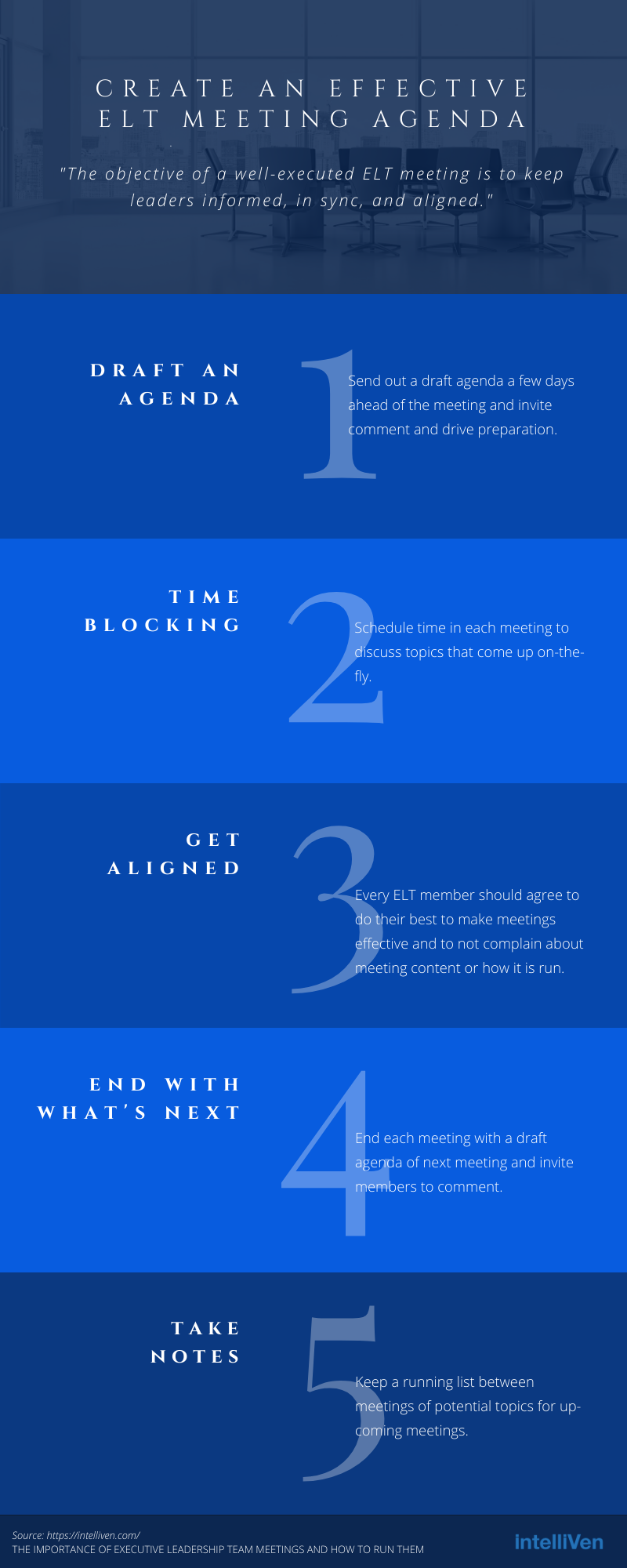ELTs Are Critical to Achieving Scale
Executive Leadership Team meetings are critical to a business achieving scale. Even with infinite grit, determination, drive, and brilliance, leadership responsibilities must eventually be assigned such that a system to keep things coming together for collective leadership attention is required.
With scale comes the need for leaders to specialize and focus their span of control. ELT meetings are for leaders to connect and align across their areas of specialization. Even the best run $20M business will plateau on the path to $50M if leaders stick with an ad hoc approach to operations and governance.
The objective of a well-executed ELT meeting is to keep leaders informed, in sync, and aligned.
As a business succeeds and gets larger, so too will the ranks of its top leaders and of the next level of leaders to include junior partners who may be geographically remote. In the face of expansion, the leadership team needs a forum and orderly process for information to flow up to, and out from, the ELT. The insights, agreements and decisions of the ELT flow throughout the organization, and need to be based on accurate and relevant decision making information from across the organization.
Proper Planning, Having Discipline, and Respecting Each Other’s Time Goes a Long Way
Schedule ELT meetings at a regular time that will, more often than not, be safe from the myriad of possible interruptions. Early Monday mornings is usually a good choice because there are usually few distractions at the beginning of the day and the week and it gives the rest of the week to follow up on meeting assignments. Monday mornings also give team members the weekend to reflect and to contemplate agenda items.
During meetings, it is critical to be disciplined. It is especially important for every member, especially the CEO, to make a firm commitment to stay mentally and physically present. That is: show-up and do not allow emails, texts, calls or any other interruptions during the meeting. Respecting each other’s time will go a long way towards building a high-performance leadership team.
Create an Effective Agenda
The CEO owns the ELT agenda, but each ELT member is co-author in that each has the responsibility, opportunity, and the right to add items to the agenda. Consider these tips to running an effective ELT meeting:
- Send out a draft agenda a few days ahead of the meeting and invite comment and drive preparation.
- Schedule time in each meeting to discuss topics that come up on-the-fly.
- Every ELT member should agree to do their best to make meetings effective and to not complain about meeting content or how it is run.
- End each meeting with a draft agenda of next meeting and invite members to comment.
- Keep a running list between meetings of potential topics for up-coming meetings.
ELT Meeting Best Practices
Members must prepare for agenda items they are to lead. Submit materials in advance to someone assigned to gather and distribute two-days ahead of the meeting to allow time for members to read through and develop a point of view on each topic.
If it is unavoidable, reschedule or cancel a meeting, but do not make it a habit. Only the most urgent matters should disrupt the ELT process. For example, a pending merger or acquisition or an HR catastrophe might justify disruption, but not much else.
Keep meetings to an agreed upon length; 1.5 – 2 hours is plenty of time for a well-run ELT meeting.
Start and end meetings on time. Discipline is paramount, or chaos will reign.
Agenda topics are of two types: Routine and Non-routine.
- Routine items: Things that are covered in every meeting with standard advance materials conveying the state of each compiled and distributed in advance:
- Upcoming key events.
- Metrics
- Headcount
- Upcoming key events.
- Non-routine: One to three of the most important things going on in the business should be discussed in each meeting. Those leading each discussion need to be notified well in advance and have taken the time to prepare and distribute supporting materials in advance. For example:
- ELT member 1 – walk us through the LAP business plan.
- ELT member 2 – walk us through the BD plan for 2020 and 2021.
- ELT member 3 – walk us through the facilities plan.
- ELT member 1 – walk us through the LAP business plan.
Invite non-ELT guests to prepare and present to the ELT from time to time to give up-and-coming leaders a forum in which to shine and for them to get input directly from the top team.
- Examples:
- Talent Management Program leader – walk us through the Talent Manager program and update us on how it is going relative to plans.
- Researcher – walk us through the research unit’s scale model.
- Project Manager – walk us through the implementation progress and update us on how it is going relative to plan.
- Talent Management Program leader – walk us through the Talent Manager program and update us on how it is going relative to plans.
- Treat guests as guests (just because they are invited to one ELT does not qualify them to be ELT members). Coach them to prepare and to provide details on what they are doing and how it is going. This is a presentation and they need to take preparation and presentation seriously.
- Once the organization sees how guests are involved, there will be a step-function increase in performance from the guests. It will be seen as important to be invited to present to the ELT.
Remember: discipline is paramount, or chaos will reign.
About the Author
Eric Palmer has 30+ years of outstanding success as a lead operating executive in private, public, private equity owned, and venture capital backed companies. He is particularly adept at strategy formulation, operational execution, International operations, M&A, leveraged debt, IPOs, and working with professional funders.
Other Posts by Eric Palmer
What Makes and Exceptional WWW
SEE ALSO:
- This post describes the Core Leadership Team role and responsibilities. The CLT and the ELT are the same thing.
- This document outlines a structure for operating meetings for the board of directors, executive operating committee (a.k.a. Executive Leadership Team), and management operating team (a.k.a. Senior Leadership Team) with the agenda, frequency, and membership for each.
- This post describes how to run operating meetings (a.k.a. senior leadership team meetings).
- How to use ground rules to guide productive meetings
- How to run a great meeting
- Eight reasons executive review meetings fail


